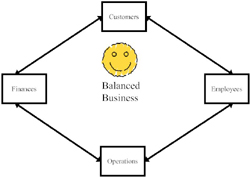Entrepreneurs are usually so anxious to get their enterprises going that they don’t pay enough attention to planning for the long term future of their operations. This is why so many entrepreneurial businesses work satisfactorily for the first year or so but often need a complete re-think just to keep the business going after that.
Who’s the boss?
Take a 50-50 partnership as an example. The two partners are fired up with enthusiasm and both have lots to do when they launch the business. The weakness in this structure only becomes apparent with the passage of time when the flaws begins to cause problems:
One partner works much harder than the other
One partner is a much better manager than the other
The team is confused over who makes the decisions
One partner is away and a crisis arises
The partners argue and can’t reach a consensus
Every business needs a chief, a head, a CEO. This person needs to be agreed upon from the beginning and should be the one best qualified by experience, training or ability for the position. An ‘equal partnership’ is an invitation to entrepreneurial disaster, if not at the beginning of a business then at some critical moment down the track.
The one big customer
Many entrepreneurial businesses have their origins in a previous vendor/customer relationship. Bob has been selling a company’s line of cosmetics to Alan’s department store for five years when one day Alan asks: “Bob, if I gave you a three year contract could you source these products for me for twenty percent less?”
Bob seizes the opportunity and once he’s organized his sources he resigns from his employer of the past five years and sets out on his own. His future is assured. He has his own business and a customer that will keep him going for at least the next three years. Where can he go wrong?
Being dependent on just one or two big customers can be a big mistake. Unless it can acquire more customers and use them as the basis for growth before the foundation customer’s contracts expire Bob’s business is heading for a crisis from day one.
The original customer or customers can be affected by a decline in business conditions, by the departure of the entrepreneur’s key contacts, or by a better offer from somewhere else. And when they go, if Bob hasn’t built up his customer base Bob’s business will go too.
The lowest-price model
Entrepreneurs are always on the lookout for a bargain, and they know that offering the lowest prices is a good way to get the attention of consumers. What better way to get a new business off the mark quickly than to offer ‘the lowest prices in town’ or ‘we’ll beat anybody else by 10%’. Unfortunately, it’s also a way to go out of business quickly.
A business needs cash flow to grow and inadequate margins will invariably lead to cash flow starvation. Just a few unexpected expenses can empty the bank account and bring the whole enterprise to a grinding halt.
Price sensibly and base your business model on being able to charge enough to pay your expenses, generate a profit, and even build up a cash reserve. Being an entrepreneur isn’t about low prices; it’s really about having something so good that people will pay you for it.
And speaking of money
Cash flow problems aren’t limited to entrepreneurs, of course. But since most entrepreneurial enterprises are also small businesses they can easily rush into opening their doors without enough capital to fund their operations past the first couple of months.
Start-up capital has to be sufficient to see the business through its first year even if the sales and cash flow forecasts seem to indicate the money will come flooding into the cash registers from the first day of trading. Entrepreneurs tend to be optimistic about such things, but once a business runs out of capital it runs out of business too.
During the planning stages have the draft business plan reviewed carefully and impartially by someone who knows about businesses and has a realistic perspective on both the fledgling enterprise and the marketplace. Be absolutely certain that its operations will generate sufficient cash flow to meet projected expenses.
There’s one way to get a picture of just how disastrous an overoptimistic business plan can be. Take the projected financial results for the first year, then double the expenses. Do it again but this time halve the income. Since the original figures for expenses were probably too low, and the income estimates were probably too high, this isn’t an entirely impossible situation.
The market and the players in it
Entrepreneurial zeal often leads those planning a new entry into thinking that there’s got to be room for them somewhere, when they’re really about to enter a market that already has sufficient players to satisfy demand.
Study the market carefully before entering it as a player. Entering a market that’s already oversupplied means only one thing; somebody’s going to go out of business and that’s usually the newest entry. Even a market that apparently has openings may be saturated in certain strata – how many value players are there? How many boutique operators and how many discounters?
This is a familiar trap for tradespeople going out on their own. Only so many houses or swimming pools are going to be built in a community in any given year. New entries into these categories face a serious struggle for survival as any customers they attract will have to be taken from established competitors, usually on the basis of lower pricing.
The same dangers apply to the ‘instant growth industries’ – often franchises or semi-franchised operations, that spring up each year and have their day in the sun, only to fade quickly and disappear forever like 8-track stereos. By the time a trend has achieved high visibility it’s usually past its peak, and that means little or no room for late entries.
Real entrepreneurs are phoenixes
When entrepreneurs make mistakes they’re often big ones, but they at least have the benefit of happening quickly. Entrepreneurs don’t hang on long to businesses that aren’t working; they cut their losses and turn their entrepreneurial eyes in other directions.
They also have the ability to learn from their mistakes. If they didn’t plan well enough the first time they’ll do a better job of planning the future of their next business. By avoiding the ‘big five’ mistakes outlined above, entrepreneurial businesses will have a much greater chance of survival and even success.




